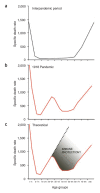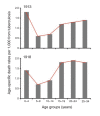Protective immunity and susceptibility to infectious diseases: lessons from the 1918 influenza pandemic - PubMed (original) (raw)
Review
Protective immunity and susceptibility to infectious diseases: lessons from the 1918 influenza pandemic
Rafi Ahmed et al. Nat Immunol. 2007 Nov.
Abstract
The influenza pandemic of 1918 killed nearly 50 million people worldwide and was characterized by an atypical W-shaped mortality curve, where adults between the ages of 30-60 years fared better than younger adults aged 18-30 years. In this review, we will discuss why this influenza virus strain was so virulent and how immunological memory to the 1918 virus may have shaped the W mortality curve. We will end on the topic of the 'honeymoon' period of infectious diseases--the clinically documented period between the ages of 4-13 years during which children demonstrate less morbidity and/or mortality to infectious diseases, in general, compared with young adults.
Figures
Figure 1. Deaths per 100,000 in the United States caused by influenza-pneumonia.
(a) A U-shaped mortality curve was observed for different age groups for the interpandemic period of 1911–1915. (b) A W-shaped mortality curve was observed for the pandemic year 1918. (c) A V-shaped mortality curve might have been observed in 1918, if the population had not been exposed previously (before 1889) to an H1-like influenza virus (the specific death rates were taken from ref. 50).
Figure 2. Influenza A and B viruses circulating in the human population.
Influenza A viruses with three different hemagglutinin subtypes (H1, H2 and H3) and two different neuraminidase subtypes (N1 and N2) have been identified, and the introductions of these (antigenic shift as a result of reassortment) strains were associated with pandemics. All influenza viruses also undergo continuing antigenic change (antigenic drift as a result of mutation) during interpandemic years. Broken lines indicate that no virus isolates are available from that time period.
Figure 3. The Flu Orphans.
Children in the remote Alaskan village of Nushagak survived the 1918–1919 influenza pandemic. However, most of their parents and grandparents succumbed to the 1918 pandemic virus, probably because they had not been exposed to an earlier H1-like influenza virus as a result of their geographic isolation. The photograph was taken in the summer of 1919. Printed with permission from the Alaska State Library, Core: Nushagak-People-4, Alaskan Packers Association, PCA 01-2432.
Figure 4. The honeymoon period of tuberculosis.
Age-specific death rates from tuberculosis (all forms) in England and Wales for 1913 and 1918. Note that the 5–14-year-old group had a lower mortality rate than the other age groups (data from ref. 10).
Figure 5. Antibody responses to the human papillomavirus (HPV) vaccine.
Note that 9–12-year-old girls made higher antibody responses than young women (18–23 year olds). The data shown in this figure are for HPV type 6 at 7 months after vaccination. A similar trend in the antibody responses was seen for the other three HPV types present in the vaccine,.
Similar articles
- Geography may explain adult mortality from the 1918-20 influenza pandemic.
Mamelund SE. Mamelund SE. Epidemics. 2011 Mar;3(1):46-60. doi: 10.1016/j.epidem.2011.02.001. Epub 2011 Feb 21. Epidemics. 2011. PMID: 21420659 - Observations on mortality during the 1918 influenza pandemic.
Luk J, Gross P, Thompson WW. Luk J, et al. Clin Infect Dis. 2001 Oct 15;33(8):1375-8. doi: 10.1086/322662. Epub 2001 Sep 17. Clin Infect Dis. 2001. PMID: 11565078 - What can we learn from reconstructing the extinct 1918 pandemic influenza virus?
Palese P, Tumpey TM, Garcia-Sastre A. Palese P, et al. Immunity. 2006 Feb;24(2):121-4. doi: 10.1016/j.immuni.2006.01.007. Immunity. 2006. PMID: 16473822 No abstract available. - H1N1 influenza pandemics: comparing the events of 2009 in Mexico with those of 1976 and 1918-1919.
Franco-Paredes C, Hernandez-Ramos I, Del Rio C, Alexander KT, Tapia-Conyer R, Santos-Preciado JI. Franco-Paredes C, et al. Arch Med Res. 2009 Nov;40(8):669-72. doi: 10.1016/j.arcmed.2009.10.004. Epub 2010 Jan 6. Arch Med Res. 2009. PMID: 20304254 Review.
Cited by
- Dissecting influenza virus pathogenesis uncovers a novel chemical approach to combat the infection.
Oldstone MB, Teijaro JR, Walsh KB, Rosen H. Oldstone MB, et al. Virology. 2013 Jan 5;435(1):92-101. doi: 10.1016/j.virol.2012.09.039. Virology. 2013. PMID: 23217619 Free PMC article. Review. - The age distribution of mortality due to influenza: pandemic and peri-pandemic.
Reichert T, Chowell G, McCullers JA. Reichert T, et al. BMC Med. 2012 Dec 12;10:162. doi: 10.1186/1741-7015-10-162. BMC Med. 2012. PMID: 23234604 Free PMC article. - Immunopathology of highly virulent pathogens: insights from Ebola virus.
Zampieri CA, Sullivan NJ, Nabel GJ. Zampieri CA, et al. Nat Immunol. 2007 Nov;8(11):1159-64. doi: 10.1038/ni1519. Nat Immunol. 2007. PMID: 17952040 Free PMC article. Review. - Back to the Future: Lessons Learned From the 1918 Influenza Pandemic.
Short KR, Kedzierska K, van de Sandt CE. Short KR, et al. Front Cell Infect Microbiol. 2018 Oct 8;8:343. doi: 10.3389/fcimb.2018.00343. eCollection 2018. Front Cell Infect Microbiol. 2018. PMID: 30349811 Free PMC article. Review. - Innate immune modulation by RNA viruses: emerging insights from functional genomics.
Katze MG, Fornek JL, Palermo RE, Walters KA, Korth MJ. Katze MG, et al. Nat Rev Immunol. 2008 Aug;8(8):644-54. doi: 10.1038/nri2377. Nat Rev Immunol. 2008. PMID: 18654572 Free PMC article. Review.
References
- Palese P, Shaw ML. Fields' Virology. 2007. Orthomyxoviridae: the viruses and their replication.
Publication types
MeSH terms
LinkOut - more resources
Full Text Sources
Other Literature Sources
Medical




